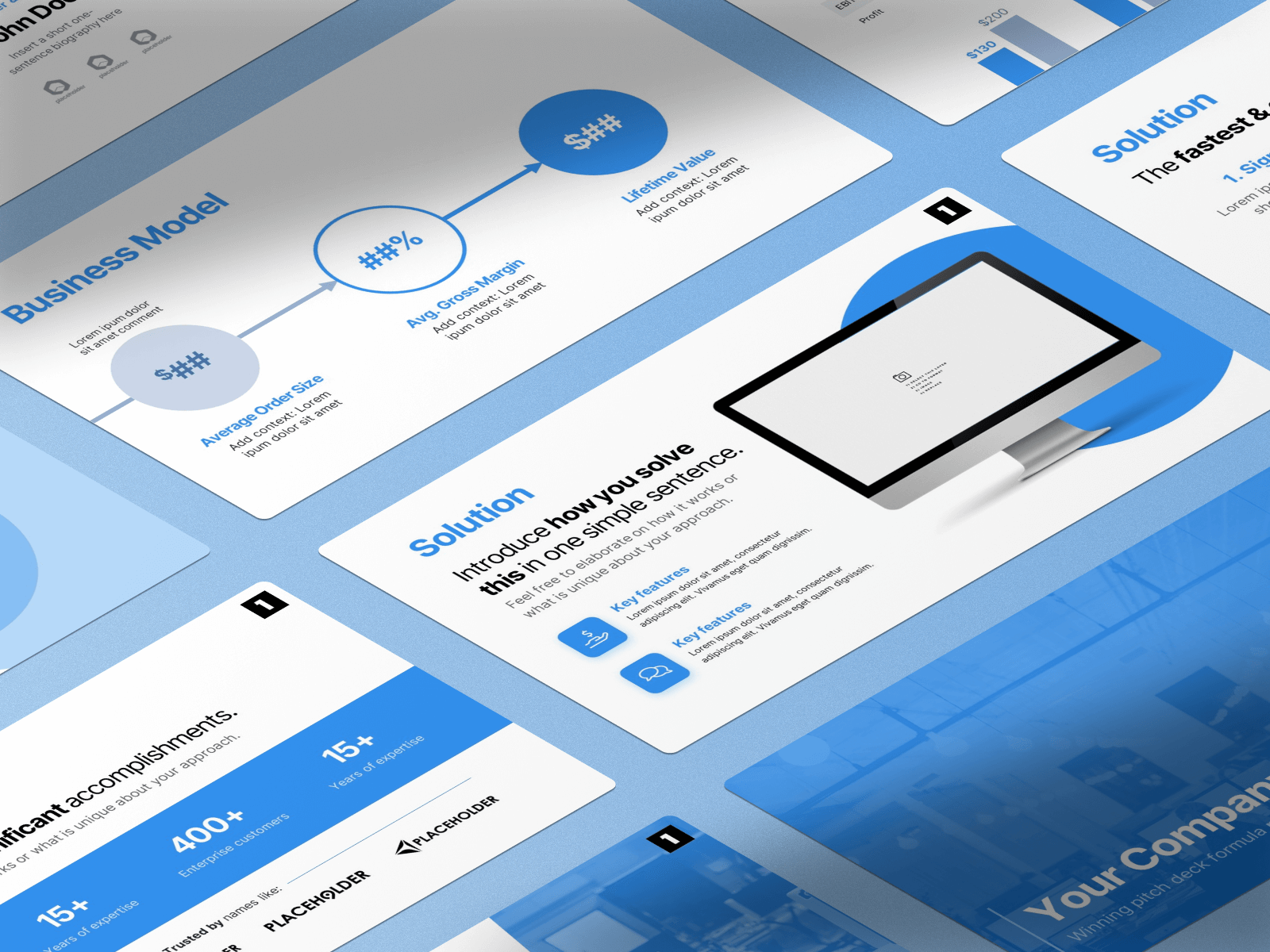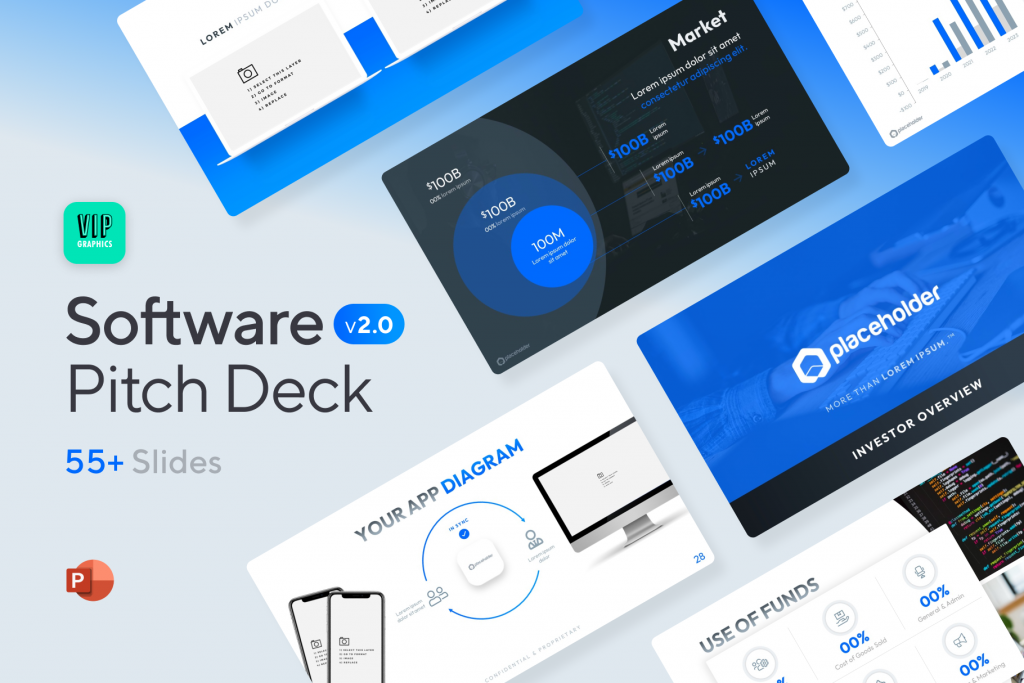Software startups are experiencing a significant boom in today’s technology-driven environment. However, investors have grown increasingly discerning: as Crunchbase News reports, global funding took a notable 42% dip in Q3 of 2023.
This shift has made it more challenging for startups to secure the capital they need. In this article, we will equip you with the knowledge and strategies to overcome funding challenges and craft a compelling pitch deck to make your software / SaaS startup stand out in today’s competitive landscape.
What is a software startup pitch deck?
A pitch deck is a concise, visual presentation that outlines the critical aspects of your software startup to potential investors, partners, and stakeholders. It serves as a tool for communicating your business idea, strategy, and vision in a compelling and easily digestible format.
Just as a compelling pitch deck played a pivotal role in Amagi securing an impressive $95M for their AVOD streaming software, your startup’s pitch deck will play an instrumental role in illustrating the value of your digital product or service to potential backers and collaborators.
What is the purpose of a software startup pitch deck?
The primary purpose of a software startup pitch deck is to secure investment and support for your business. It is a powerful communication tool that helps you:
- Attract Investors: At the core, it’s a tool designed to attract investors. It’s your chance to showcase your startup’s potential return on investment, making it a compelling choice for potential backers.
- Convey Your Vision: A pitch deck serves as a medium to convey your vision and the problem you aim to solve, fostering a more profound understanding among your audience.
- Secure Partnerships: Beyond investors, it can also be instrumental in securing partnerships, strategic alliances, or collaborations that propel your startup forward.
- Guide Your Presentation: Moreover, it’s a road map for your pitch presentation, ensuring you cover all essential aspects of your startup within a limited timeframe.
Now that we understand the purpose let’s delve into the key slides that should be included in your software startup pitch deck.
What slides should be in your software startup’s pitch deck?
When looking for investors, a strong software pitch deck is not a luxury but a must. Getting the funding you need to develop your software idea can come down to how well-organized and appealing your pitch deck is.
Cover Slide
The cover slide of your software startup pitch deck is significant because it’s the first thing people will see and interact with. It should be simple, eye-catching, and easy to understand.
The name of your company should be displayed clearly on this slide, along with a unique logo that visually represents your brand. A short, powerful tagline that gives people a sneak peek at your goal is also essential.
The images and color scheme should match the personality of your brand, and the style should stay the same throughout the presentation. Your cover slide should make people want to learn more by giving them an exciting start to the story of your software company.
Problem Slide
In the problem slide, your objective is to spotlight the specific challenge that your software solution is designed to address. It’s crucial to provide a clear, concise, and relatable description of the problem, making it easier for investors to see why your solution is essential and needs to be done immediately.
Solution Slide
This is where you showcase how your software provides a practical and efficient remedy to the identified challenge. Explain how your solution will save time and money in simple, easy-to-understand language. Focus on benefits & value proposition, rather than features and technical architecture.
How It Works Slide
The How it Works slide provides an insightful walkthrough of your software’s functionality using product images or other user-friendly visuals. The goal of this slide is to remove any ambiguity regarding the software’s technicalities and present a complete picture of how it functions. Include screenshots and product images so investors can see the experience from the eyes of your customer.
Competitive Advantage / Differentiation Slide
This slide draws attention to the distinctive features of your software that make it stand out. Investors want to see that your startup has a competitive moat or secret sauce to stay ahead of the competition, and that you have a deep understanding of the market landscape your software will compete in. Pro tip: give a realistic explanation of your competitive edge and how you plan to retain and improve it as you grow & scale.
Market / Opportunity Slide
The market slide should describe the potential demand for your product, and recent developments in the market that support your chances of success. To highlight the size and potential of your target market, you can use niche-specific statistics in this section. These statistics will provide your investors with an in-depth perspective of the industry and showcase precisely why your software is poised for success.
Applications / Target Users Slide
In this slide, you should provide a thorough description of the software’s practical uses and define your ideal user base. Showcase a detailed picture of who your target audience is and why they need your service. Emphasize key pain points, user demographics, and purchasing behavior to demonstrate you know your customers and have validated demand. If you have testimonials or case studies, this is the place to show them off.
Traction Slide
The traction slide of your pitch deck is your platform for sharing noteworthy achievements that add credibility to your software solution. Whether it’s patents, high-profile clients, or positive press coverage, these milestones prove your software’s merit, scope, and depth of development.
Business Model Slide
Explain your pricing strategy and highlight critical financial parameters like profit margins and the lifetime value to customer acquisition cost (LTV/CAC) within the business model slide. This slide should provide an in-depth analysis of your software’s financial plan, outlining the steps that will be taken to achieve profitability and scale.
Team Slide
In the team slide, you must introduce your team members and their relevant qualifications and expertise. Investors seek assurance that they’re supporting a capable, well-rounded team.
This part is where you can brag about the people driving your software company forward and why they are the right people to execute on this opportunity.
Investment Slide
Include as much information as possible in the investment slide regarding the investment ask, use of funds, and associated milestones. If your startup has already received funding, be sure to mention that, and any notable investors as proof of your success. The level of detail in this slide will help you demonstrate your thorough fiscal planning and long-term vision to potential backers.
Roadmap Slide
Your long-term plans and growth strategies should be laid out in the “Roadmap” portion of your pitch deck. Investors will have a much better idea of what to expect and how you plan to get there if you provide them with this clear, comprehensive overview that shows your dedication to the project over the long haul. Make sure not to focus solely on product development alone — investors will be interested to see your go-to-market plan as well.
Vision Slide
The Vision slide is where you can describe the overarching mission and purpose of your software. This long-term perspective will help investors see how your product will impact many people and how it will fit into emerging markets. Paint a vivid picture of your startup’s potential for growth and expansion to impress investors.
Call-to-Action Slide
Wrap up your pitch with a clear call-to-action, inviting investors to join your journey. Make sure to provide clear contact information and/or next steps, so interested investors can take action immediately!
Tips for designing a winning software startup pitch deck
There are a few key factors to consider while building a pitch deck for a software firm. To help you through the process, here are some general tips:
- Don’t just focus on market size — use trends to highlight “why now.”: While the market size is essential, it’s equally crucial to showcase why your software is relevant in the current landscape. Highlight trends, changes, or events that make your solution timely and necessary.
- Cite numbers specific to your niche, not the entire software market: Investors are interested in your niche market data. Avoid broad industry statistics and focus on figures specific to your target audience.
- Focus on the market & opportunity, not the technical “how it works.”: Keep your pitch deck high-level. Investors are more interested in the problem you’re solving and the potential market opportunity than the intricate technical details of your software.
Need help with your software startup pitch deck?
Perfecting your software startup pitch deck is an essential step towards attracting investors, securing the necessary funding, and forming vital partnerships with potential clients. To streamline this process, you might want to consider exploring the Software Startup Pitch Deck Template by VIP Graphics—a carefully designed PowerPoint presentation to help your software startups’ pitch stand out. This template makes it easy to make great slides for your software company, whether you’re working on SaaS, AI, or other software innovations — check it out here.

